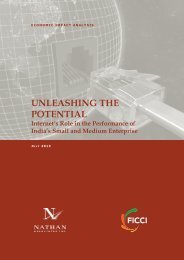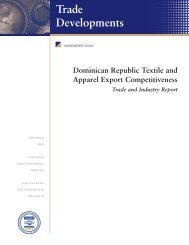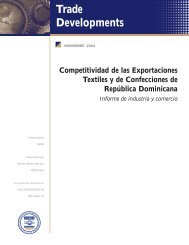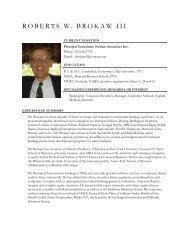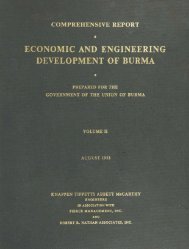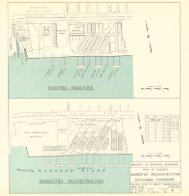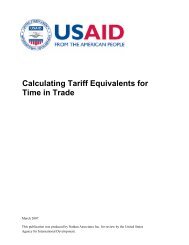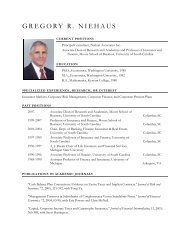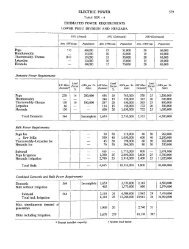Putting it to Work in Developing Countries - Nathan Associates
Putting it to Work in Developing Countries - Nathan Associates
Putting it to Work in Developing Countries - Nathan Associates
You also want an ePaper? Increase the reach of your titles
YUMPU automatically turns print PDFs into web optimized ePapers that Google loves.
Where governments deem <strong>in</strong>centives necessary,<br />
they should, at a m<strong>in</strong>imum, def<strong>in</strong>e the package<br />
carefully—lean<strong>in</strong>g perhaps <strong>to</strong> time-bound and<br />
moderate tax <strong>in</strong>centives rather than outright<br />
subsidies or other cash outlays—and subject <strong>it</strong><br />
<strong>to</strong> a rigorous cost-benef<strong>it</strong> analysis. And regardless<br />
of the particular package, specialists stress<br />
that “non-tax elements of the <strong>in</strong>vestment climate<br />
are far more important than tax <strong>in</strong>centives <strong>in</strong><br />
determ<strong>in</strong><strong>in</strong>g the level and qual<strong>it</strong>y of <strong>in</strong>vestment.”<br />
30<br />
DIRECT ACTION—<br />
PROMOTING FDI<br />
An attractive <strong>in</strong>vestment climate is nearly always<br />
a prerequis<strong>it</strong>e for attract<strong>in</strong>g FDI, but for most<br />
countries <strong>it</strong> is not enough. They must promote<br />
<strong>in</strong>vestment directly. The <strong>in</strong>vestment promotion<br />
function may be particularly important for the<br />
least developed countries. 31 Investment promotion<br />
<strong>to</strong>ok root <strong>in</strong> develop<strong>in</strong>g countries after the<br />
debt crisis of the 1980s and acceptance of the<br />
notion of “Market<strong>in</strong>g a Country.” 32 The number<br />
of <strong>in</strong>vestment promotion agencies (IPAs) surged<br />
<strong>in</strong> the 1990s w<strong>it</strong>h the emergence of the trans<strong>it</strong>ional<br />
economies of Eastern Europe and the creation<br />
of new nations from the former Soviet<br />
Union. As of 2006, the World Association of<br />
Investment Promotion Agencies (WAIPA) had<br />
204 member agencies, about 75 percent from<br />
develop<strong>in</strong>g countries.<br />
PROFILE OF INVESTMENT PROMOTION<br />
AGENCIES<br />
In most develop<strong>in</strong>g countries, IPAs are government<br />
ent<strong>it</strong>ies that report <strong>to</strong> a m<strong>in</strong>istry, though<br />
often w<strong>it</strong>hout be<strong>in</strong>g a part of <strong>it</strong> and operat<strong>in</strong>g<br />
under a separate board of direc<strong>to</strong>rs. 33 IPA boards<br />
are composed of public and private sec<strong>to</strong>r representatives,<br />
<strong>in</strong>clud<strong>in</strong>g representatives of tra<strong>in</strong><strong>in</strong>g<br />
and educational <strong>in</strong>st<strong>it</strong>utions and bus<strong>in</strong>ess associations.<br />
IPA staff, who may not necessarily be<br />
civil servants, may be paid higher salaries than<br />
counterparts <strong>in</strong> the civil service and have had<br />
careers <strong>in</strong> government, though some have private<br />
sec<strong>to</strong>r experience.<br />
Government typically supplies the vast bulk of<br />
IPA fund<strong>in</strong>g, but many agencies are try<strong>in</strong>g <strong>to</strong><br />
supplement this w<strong>it</strong>h revenues from other<br />
sources, such as for-service fees and donor<br />
agency funds (Table 5-2). When clients do pay<br />
fees, they are usually for bus<strong>in</strong>ess services, legal<br />
assistance, help <strong>in</strong> prepar<strong>in</strong>g feasibil<strong>it</strong>y studies,<br />
and support <strong>in</strong> identify<strong>in</strong>g qualified local personnel.<br />
Most IPAs cont<strong>in</strong>ue <strong>to</strong> resist fee-for-services<br />
as contrary <strong>to</strong> their market<strong>in</strong>g role.<br />
Accord<strong>in</strong>g <strong>to</strong> data from 2000, annual budgets<br />
for the IPAs of least developed countries averaged<br />
$285,000; of economies <strong>in</strong> trans<strong>it</strong>ion,<br />
Table 5-2<br />
Investment Promotion Agencies—Income Sources and Expend<strong>it</strong>ure Use of Funds<br />
Income Sources % Expend<strong>it</strong>ure Use %<br />
Government fund<strong>in</strong>g 73 Image build<strong>in</strong>g 38<br />
Revenues earned from fees 10 Investment generation 29<br />
International aid 9 Inves<strong>to</strong>r services 25<br />
Other sources 6 Policy advocacy 8<br />
Private sec<strong>to</strong>r 2<br />
Total 100 Total 100<br />
Note: Income sources from UNCTAD, The World of Investment Promotion at a Glance—A Survey of Investment<br />
Promotion Practices, ASIT Advisory Studies No. 17, Figure 4, p. 4.<br />
SOURCE: <strong>Nathan</strong> <strong>Associates</strong> based on UNCTAD data.<br />
66



